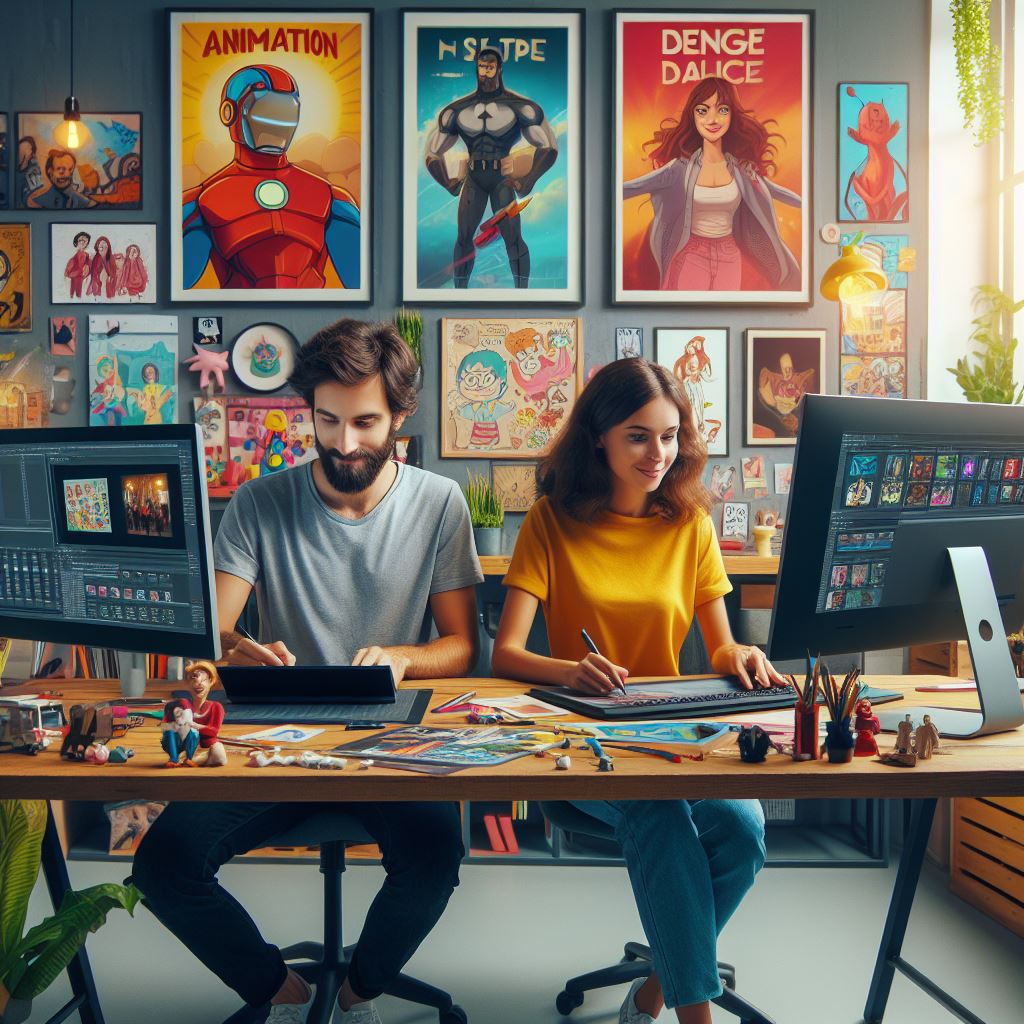Introduction
In the competitive world of animation, employers prioritize specific skill sets in US-based animation artists. These skills are crucial for securing employment opportunities and thriving in the industry.
The demand for animation artists is high, and employers expect candidates to possess a wide range of abilities and knowledge.
By showcasing these skills, artists increase their chances of landing coveted positions.
Animation artists must excel in software like Maya and Adobe Creative Suite, mastering 3D modeling, rigging, and texturing.
They showcase creative talents in drawing, sketching, and storytelling, emphasizing a unique style and innovative thinking.
Collaboration and effective teamwork are paramount; artists need strong communication skills, adaptability, and the ability to take constructive feedback.
Efficient time management is crucial for meeting deadlines and handling multiple projects, requiring organizational skills.
Problem-solving skills are valued, demanding artists to troubleshoot, think critically, and offer innovative solutions throughout the production process.
Maintaining a continuous learning mindset is essential, with employers valuing eagerness to adapt to new technologies and techniques.
Staying updated on industry trends and participating in workshops or conferences showcases dedication to professional growth.
In general, possessing the right skill sets is vital for US-based animation artists to secure employment opportunities in the industry.
Technical expertise, artistic abilities, collaboration skills, time management, problem-solving, and a desire for continuous learning are crucial for becoming a sought-after animation artist.
By honing these skills, artists can position themselves as valuable assets to employers and thrive in their careers.
Technical Skills
Animation has become an integral part of various industries, including film, gaming, advertising, and education.
As a result, employers are constantly seeking artists who possess the necessary technical skills to bring their creative visions to life.
Here are some of the technical skills that employers typically look for in animation artists:
Proficiency in software
- Maya: Maya is a widely-used 3D animation software that is highly valued in the industry. Employers often require artists to have a strong command of Maya.
- Photoshop: Photoshop is essential for creating and manipulating digital images. A good understanding of Photoshop is crucial for animation artists.
- After Effects: After Effects is a powerful tool for creating visual effects and motion graphics. Proficiency in After Effects is highly sought after by employers.
Understanding of 2D and 3D animation techniques
Animation artists need to have a solid understanding of both 2D and 3D animation techniques. This includes knowledge of keyframe animation, character rigging, motion capture, and rendering.
In 2D animation, artists work with hand-drawn or digitally created images to create a sequence of movements.
They need to understand the principles of animation, such as timing, spacing, and squash and stretch.
On the other hand, 3D animation involves creating realistic and dynamic animations using computer-generated models. Artists need to be familiar with modeling, texturing, lighting, and rendering techniques.
Transform Your Career Today
Unlock a personalized career strategy that drives real results. Get tailored advice and a roadmap designed just for you.
Start NowKnowledge of scripting and coding
Having basic knowledge of scripting and coding can give animation artists a competitive edge.
Employers appreciate artists who can write scripts or use programming languages to automate processes and create custom tools.
For example, artists who can write Python scripts to automate repetitive tasks in Maya or develop plugins for animation software are highly valued.
Familiarity with sound editing
Sound is an integral part of animation. Employers often look for artists who have a basic understanding of sound editing software, such as Adobe Audition or Pro Tools.
Animation artists may need to synchronize their animations with sound effects, dialogue, or music. Therefore, having the ability to edit sound and integrate it seamlessly into their work is a valuable skill.
Problem-solving and troubleshooting
Animation artists need to be able to solve technical problems that may arise during the production process. Employers value artists who can think critically and troubleshoot issues independently.
Whether it’s fixing a rigging problem, optimizing the rendering process, or resolving software conflicts, artists who can identify and resolve technical issues efficiently are highly sought after.
In essence, employers in the animation industry seek artists who possess a range of technical skills.
Proficiency in software like Maya, Photoshop, and After Effects, a strong understanding of 2D and 3D animation techniques, knowledge of scripting and coding, familiarity with sound editing, and problem-solving abilities are crucial for success in the field.
By acquiring these technical skills, animation artists can enhance their employability and excel in their careers.
Read: Animation Studios in the US: Big Players and Niche Firms
Artistic Abilities
Artistic abilities employers value in animation artists
Animation artists possess a wide array of artistic skills that are highly sought after by employers within the industry. These abilities are essential in bringing characters, stories, and worlds to life through animation.
- Drawing Skills: One of the most crucial skills for animation artists is strong drawing ability. Being able to accurately depict characters and objects is essential for creating compelling animations.
- Composition Knowledge: Understanding composition is vital for creating visually balanced and aesthetically pleasing animations. Animation artists must be able to arrange elements within a frame effectively.
- Color Theory Understanding: A solid comprehension of color theory enables animation artists to create captivating color schemes that enhance the mood and atmosphere of their animations.
Importance of strong drawing skills and a solid understanding of composition and color theory
Drawing skills serve as the foundation for an animation artist’s abilities. The ability to sketch characters and environments accurately allows artists to create animations with convincing movement and lifelike qualities.
Furthermore, a solid understanding of composition is crucial for guiding viewers’ focus and conveying storytelling elements effectively.
Proper composition helps direct the viewers’ attention and creates a cohesive visual narrative. Color theory plays a vital role in establishing the overall feel of an animation.
By utilizing appropriate color choices, animation artists can evoke specific emotions, establish atmosphere, and enhance the visual impact of their work.
The need for artists to have a unique artistic style that sets them apart from others
In the highly competitive animation industry, having a unique artistic style is essential for standing out from the crowd. Employers seek artists who can bring a fresh and distinctive perspective to their work.
Having a unique style allows animation artists to develop a recognizable brand and attract a dedicated audience.
It also demonstrates their ability to think outside the box and bring a fresh perspective to each project.
An artist’s individual style can also contribute to the overall aesthetic of a production, making their work valuable and sought after by employers in the industry.
Transform Your Career Today
Unlock a personalized career strategy that drives real results. Get tailored advice and a roadmap designed just for you.
Start NowAnimation artists need to possess a range of artistic abilities to thrive in the industry.
Strong drawing skills, a solid understanding of composition and color theory, and a unique artistic style are highly valued by employers seeking talented animation artists.
By honing these abilities, artists can create captivating animations that engage audiences and leave a lasting impression.
Ultimately, these skills contribute to the success and impact of animations in the ever-evolving world of entertainment.
Read: US Animation Schools: Top Institutions to Kickstart Your Career
Storytelling and Narrative Skills
In the animation industry, storytelling and narrative skills are of utmost significance. These skills allow artists to create captivating and immersive experiences for viewers.
Compelling Characters and Engaging Narratives
- Artists need to be able to develop characters that resonate with the audience.
- Characters should have depth, personality, and relatability to make the story more compelling.
- Engaging narratives keep the audience hooked and eager to follow the story until the end.
- Unique and well-developed storylines hold the key to capturing and maintaining viewers’ interest.
Understanding Storyboarding and Animatics
- Storyboarding is a crucial step in the animation process, as it helps artists visualize the story.
- By creating a sequence of hand-drawn or digital sketches, artists plan out the flow and composition of each scene.
- Storyboards act as a blueprint for the animation, ensuring a coherent and cohesive narrative.
- Animatics, on the other hand, bring storyboards to life by adding rough timing and sound effects.
- Understanding storyboarding and animatics allows artists to effectively communicate their vision to the rest of the team.
Importance in Building Emotional Connections
- Skillful storytelling and narrative techniques foster emotional connections between characters and the audience.
- When viewers can empathize with the characters and their journey, they become more invested in the story.
- Emotional resonance enhances the impact of the animation, creating a lasting impression on the viewers.
- Animators must master the art of evoking emotions through pacing, dialogue, music, and visual cues.
Conveying Complex Ideas and Themes
- Storytelling skills enable artists to convey complex ideas and themes in a visually appealing and understandable manner.
- Animation provides a unique medium to explore and communicate abstract concepts.
- Through imaginative storytelling, animators can tackle serious topics, educate, and inspire audiences.
- Metaphors, allegories, and symbolism can be effectively employed to convey deeper messages.
Collaborative and Cross-disciplinary Work
- Storytelling in animation involves collaboration between animators, writers, directors, and designers.
- Effective communication and teamwork are essential to align the narrative vision and artistic style.
- Animators must collaborate closely with scriptwriters to bring the characters and storyline to life.
- They also work with sound designers and composers to ensure the audio elements complement the narrative.
Evolution of Storytelling Techniques
- As the animation industry evolves, storytelling techniques continue to advance.
- Artists must stay updated with new trends and techniques to remain competitive in the field.
- The emergence of technologies like virtual reality and augmented reality opens new possibilities for storytelling.
- Animators need to adapt and incorporate these advancements to create unique and immersive experiences.
Generally, storytelling and narrative skills are invaluable for US-based animation artists.
The ability to create compelling characters, understand storyboarding, and convey complex ideas enables artists to create impactful animations.
Collaboration, emotional connection, and staying abreast of industry advancements further solidify these skills’ importance in today’s animation industry.
Read: Breaking Into Animation: A Guide for Newbies in the USA

Collaboration and Communication Skills
When it comes to Collaboration and communication, these skills are essential for animation artists to thrive in the industry. Here are the reasons why:
Importance of Collaboration and Communication Skills
- Effective collaboration allows animation artists to combine their individual talents and skills.
- Collaboration fosters creativity and innovation as artists exchange ideas and build upon each other’s work.
- Strong communication skills ensure smooth coordination and understanding among team members.
- It helps prevent misunderstandings and ensures that everyone is on the same page.
The Need for Artists to Work Well in a Team Environment
- Animation projects are rarely solo endeavors; teams work together to bring ideas to life.
- Artists must be able to cooperate, share responsibilities, and support each other to achieve the best results.
- A collaborative work environment nurtures a sense of unity and collective ownership.
- Working well in a team also means being open to constructive criticism and different perspectives.
The Ability to Effectively Communicate Ideas
- An animation artist must articulate their vision clearly to ensure their ideas are understood.
- Effective communication allows for better decision-making and problem-solving within the team.
- Artists need to express their concepts, preferences, and concerns effectively to create a cohesive animation.
- Clear communication ensures that everyone works towards the same artistic goals.
Taking Feedback and Making Necessary Revisions
- Receiving feedback is crucial for the growth and improvement of animation artists.
- Being open to feedback helps artists identify areas for improvement and refine their work.
- Artists must welcome suggestions and revisions from team members and clients.
- Adapting based on feedback leads to better collaboration and a superior end product.
Essentially, collaboration and communication skills are vital for animation artists. These skills enable them to work effectively in a team, communicate their ideas, and incorporate feedback for continuous improvement.
Read: Salary Overview: What Animators Earn in Different States
Problem-Solving and Adaptability
In the animation industry, problem-solving and adaptability play a crucial role in the success of artists.
Animation projects often come with technical challenges that require creative solutions. The ability to overcome these challenges is highly valued in the industry.
Problem-Solving Skills
- Analytical Thinking: Animation artists need to analyze complex problems and break them down into manageable components.
- Attention to Detail: Paying attention to intricate details helps artists identify potential problems and find solutions.
- Creativity: Finding innovative and imaginative solutions to technical challenges can make animations stand out.
- Resourcefulness: Being resourceful and utilizing available tools and techniques can help overcome limitations.
- Collaboration: Problem-solving often requires teamwork and the ability to work with others to find effective solutions.
Adaptability in the Animation Industry
- Technological Advances: The animation industry is dynamic, constantly evolving, and embracing new technologies. Artists need to adapt to these changes to stay relevant.
- Industry Trends: Adapting to changing trends, styles, and audience preferences is necessary for success in the animation industry.
- Software Proficiency: Learning and mastering new software tools and techniques is crucial for artists to adapt to evolving industry standards.
- Meeting Client Expectations: Adapting to different client requirements and expectations is essential for successful project completion.
- Time Management: Being adaptable helps artists adjust to tight deadlines and manage projects efficiently.
The Role of Problem-Solving and Adaptability in Animation
Problem-solving and adaptability are integral to the animation industry due to the following reasons:
1. Overcoming Technical Challenges
Animation projects often present technical hurdles, such as rendering issues, software bugs, or complex character animations.
Artists with problem-solving abilities can identify the root cause of the problem and find creative solutions. This enables smoother workflow and ensures project timelines are met.
2. Finding Creative Solutions
In the animation industry, finding unique and innovative solutions is highly valued. Artists who can think outside the box and approach problems creatively can bring a fresh perspective to their work sets.
This creativity distinguishes their animations from others and makes them more appealing to clients and audiences.
Transform Your Career Today
Unlock a personalized career strategy that drives real results. Get tailored advice and a roadmap designed just for you.
Start Now3. Adapting to New Technologies
The animation industry is continually advancing technologically. Artists who can adapt to new software, tools, and techniques remain competitive.
They can explore new possibilities and create animations that utilize the latest technological advancements, further enhancing their artistic capabilities.
4. Embracing Industry Trends
Animation styles and trends change over time. Adaptable artists who stay updated with industry trends can create animations that resonate with contemporary audiences.
This ensures their work remains relevant and appealing in a constantly evolving industry.
5. Meeting Client Expectations
Each project in the animation industry comes with specific client requirements. Artists who can adapt their skills and techniques to meet these expectations have a higher chance of success.
Their ability to tailor their work to suit different client demands helps build strong professional relationships and fosters repeat business.
Basically, problem-solving skills and adaptability are vital attributes for animation artists.
These skills enable them to overcome technical challenges, find creative solutions, adapt to new technologies and industry trends, and meet client expectations.
By nurturing these skills, animators can excel in a constantly evolving and competitive industry.
Uncover the Details: Exploring New York’s Pioneering Interior Design Scene
Conclusion
Employers in the US animation industry seek certain key skill sets in artists.
These include proficiency in 2D and 3D animation software, strong drawing and illustration skills, ability to work collaboratively in a team, and a solid understanding of storytelling and character development.
Aspiring artists should focus on developing and honing these skills to increase their employment prospects.
By taking courses, attending workshops, and practicing regularly, they can improve their technical skills and artistic abilities.
They should also consider building a portfolio that showcases their best work and demonstrates their range of skills.
Continuous learning is crucial in this industry. Artists must stay updated with the latest software, techniques, and industry trends.
This can be achieved by joining professional associations, attending conferences, and engaging in online communities.
Additionally, networking with professionals in the field can help artists stay informed about job opportunities and gain valuable insights.
By acquiring the desired skill sets and staying informed about industry developments, aspiring animation artists can enhance their chances of securing employment.
The animation industry is dynamic and highly competitive, but with dedication, persistence, and a commitment to continuous learning, artists can thrive and succeed in this exciting field.
Transform Your Career Today
Unlock a personalized career strategy that drives real results. Get tailored advice and a roadmap designed just for you.
Start Now



